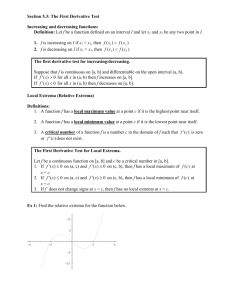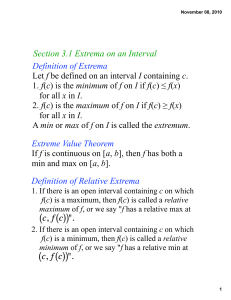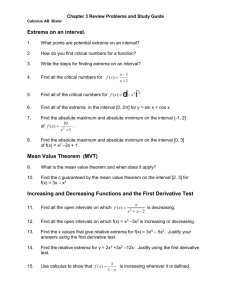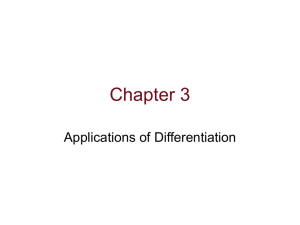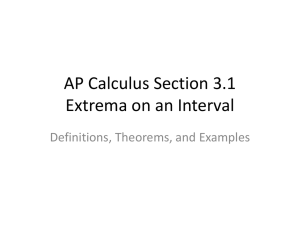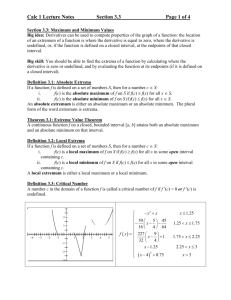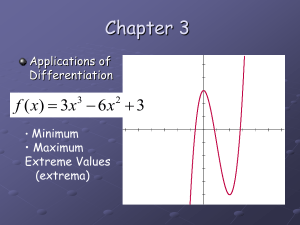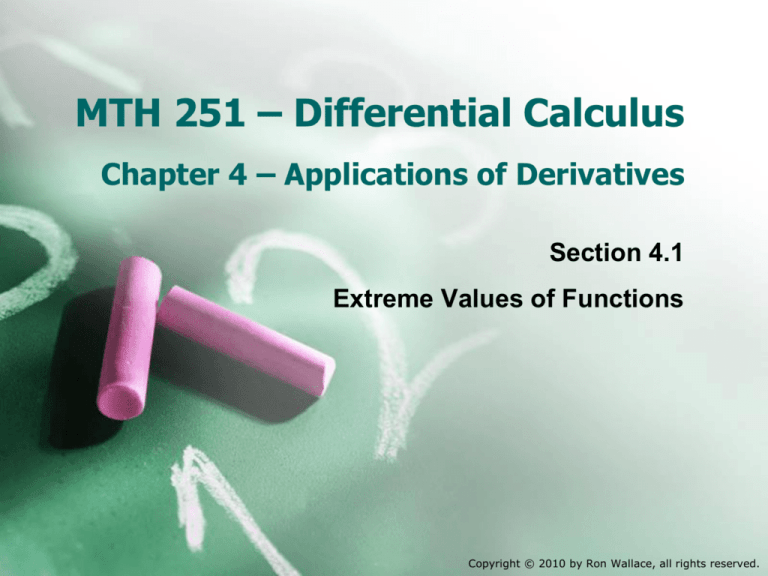
MTH 251 – Differential Calculus
Chapter 4 – Applications of Derivatives
Section 4.1
Extreme Values of Functions
Copyright © 2010 by Ron Wallace, all rights reserved.
Terminology
• The following are the same …
Absolute (aka: Global) Extrema
Absolute (aka: Global) Minimum and/or Maximum
Extreme Values
• Basic problem of this chapter …
Determine the extreme values of a function over an
interval.
i.e. Given f(x) where x [a,b] or (a,b) or [a,b) or (a,b];
determine the largest and/or smallest value of f(x).
• Note: The extreme values are values of the function.
The extreme values occur at one or more values of x
in the interval.
Max & Min – Formal Definitions
• f(x) has an Absolute Maximum over a domain D at
a point x = c if and only if f(x) ≤ f(c) for all x in D.
• f(x) has an Absolute Minimum over a domain D at
a point x = c if and only if f(x) ≥ f(c) for all x in D.
Note: Absolute Extrema may occur at more than
one value of x.
Possible Locations of Extrema
• Top of a peak
• Bottom of a valley
• End point
• Point of discontinuity
the function must be defined
Do Extrema Exist?
• Possibilities …
Both max & min?
Max but no min?
Min but no max?
No max or min?
• The Extreme Value Theorem
If f(x) is continuous over (aka: on) [a,b], then f(x)
has a absolute maximum value M and an
absolute minimum value m over the interval.
• Note that m ≤ f(x) ≤ M for all x [a,b] and …
• … there exists x1 & x2 [a,b] where f(x1) = m and
f(x2) = M
Local Extrema
• If there is some open interval that contains x = c
where f(c) is an extrema over that interval, then
f(c) is a Local Extrema.
aka: Relative Extrema
• The left endpoint of the domain of a function is
a local extrema.
• A right endpoint of the domain of a function is a
local extrema.
Finding Extrema
• Some facts …
Absolute extrema are also relative extrema.
Possible locations of relative extrema are the same
as absolute extrema
• i.e. peaks, valleys, endpoints, discontinuities
Peaks & Valleys occur at “critical points”
• Points where f ’(x) is zero or undefined
• Note: Not all critical points are extrema
Proof regarding Critical Points
• If f(c) is a local maximum and f’(c) exists, then
f’(c) = 0.
Local Max implies that f(x) ≤ f(c) for some interval
containing c. That is, f(x) – f(c) ≤ 0
f '(c ) lim
f ( x ) f (c )
xc
f '(c ) lim
f ( x ) f (c )
xc
x c
x c
0
0
Since these must
be equal …
f '( c ) 0
The proof for local minimums would be essentially the same
(all of the inequalities would be reversed).
Finding Extrema
• Some facts …
Absolute extrema are also relative extrema.
Possible locations of relative extrema are the same
as absolute extrema
• i.e. peaks, valleys, endpoints, discontinuities
Peaks & Valleys occur at “critical points”
• Points where f ’(x) is zero or undefined
• Note: Not all critical points are extrema
• Method … for closed intervals
1. Find the values of x of all critical points.
•
i.e. f’(x) = 0 or DNE
2. Calculate f(x) for all critical points and endpoints.
3. The extrema are the largest and smallest of the
values in step 2.
Finding Extrema – Example
• Method … for closed intervals
1. Find the values of x of all critical points.
•
i.e. f’(x) = 0 or DNE
2. Calculate f(x) for all critical points and endpoints.
3. The extrema are the largest and smallest of the
values in step 2.
•
Determine the extrema for …
f ( x ) 2 x 3 9 x 2 , x [1,5]
20
3
Extrema on Open Intervals
• Instead of calculating the value of the function
at the endpoint, you must calculate the limit as x
approaches the endpoint.
• Method … for open intervals
1. Find the values of x of all critical points.
•
i.e. f’(x) = 0 or DNE
2. Calculate f(x) for all critical points.
3. Calculate the limits at the endpoints.
•
one sided limits
4. The extrema are the largest and smallest of the
values in step 2 provided that they are larger or
smaller than the limits in step 3.
Note: Semi-open intervals will use a combination of the two previous cases.
Finding Extrema – Example
• Method … for open intervals
1. Find the values of x of all critical points.
•
i.e. f’(x) = 0 or DNE
2. Calculate f(x) for all critical points.
3. Calculate the limits at the endpoints.
•
one sided limits
4. The extrema are the largest and smallest of the
values in step 2 provided that they are larger or
smaller than the limits in step 3.
•
Determine the extrema for …
f ( x)
1
1 x
2
Domain?
Finding Extrema – Example
•
Determine the extrema for … (note: semi-open)
f ( x) ( x 1)2 , x [2,2)
Finding Extrema – Example
•
Determine the extrema for … (note: open … domain?)
f ( x ) x 3 3x 2

